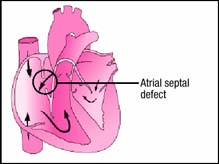Atrial septal defect
Description
Acyanotic congenital heart defect that features an opening between the left and right atria, which allows blood to flow from left to right, resulting in ineffective pumping of the heart, thus increasing the risk of heart failure
Three types:
Ostium secundum defect (the most common type): occurs in the region of the fossa ovalis and, occasionally, extends inferiorly, close to the vena cava
Sinus venosus defect: occurs in the superior-posterior portion of the atrial septum, sometimes extending into the vena cava, and almost always associated with abnormal drainage of pulmonary veins into the right atrium (versus the left atrium)
Ostium primum defect: occurs in the inferior portion of the septum primum and is usually associated with atrioventricular valve abnormalities (cleft mitral valve) and conduction defects
Accounts for about 10% of congenital heart defects
Twice as common in females as in males, with a possible familial tendency; usually associated with genetic syndrome, such as Holt-Oram syndrome or trisomy 21
Pathophysiology
Blood shunts from the left atrium to the right atrium because left atrial pressure is normally slightly higher than the right atrial pressure. (See Understanding ASD.)
Stay updated, free articles. Join our Telegram channel

Full access? Get Clinical Tree



